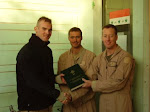 Genesis 15, 5-12. 17-18; Psalm 27; Philippians 3, 17-4, 1; St. Luke 9, 28-36
Genesis 15, 5-12. 17-18; Psalm 27; Philippians 3, 17-4, 1; St. Luke 9, 28-36
The Lord "took with him Peter and John and James, and went up on the mountain to pray. And as he was praying, the appearance of his countenance was altered, and his raiment became dazzling white." (Lk 9. 28-29) Why does the Lord reveal his glory to the Apostles in this way?
St. Thomas Aquinas teaches that this grace was given to strengthen the Apostles for the Cross to come by giving them a glimpse of the Resurrection which would be purchased only by the blood shed upon the Cross. "For a person to go straight along the road, he must have some knowledge of the end--just as an archer will not shoot an arrow straight unless he first sees the target....This is particularly necessary if the road is hard and rough, the going heavy, and the end delightful" (Summa theologiae, III, q. 45, a. 1).
We savor in the Lord's Transfiguration a foretaste of the heavenly glory which awaits the faithful. Our bodies will share in his brightness, "by which the bodies of the saints shall shine like the sun, according to the words of our Lord recorded in the Gospel of St. Matthew: 'The righteous will shine like the sun in the kingdom of their Father' (Mt 13:43). To remove the possibility of doubt on the subject, he exemplifies this in his Transfiguration. This quality the Apostle sometimes calls glory, sometimes brightness: 'He will change our lowly body to be like his glorious body' (Phil 3:21); and again, 'It is sown in dishonour, it is raised in glory' (1 Cor 15:43). Of this glory the Israelites beheld some image in the desert, when the face of Moses, after he had enjoyed the presence and conversation of God, shone with such lustre that they could not look on it (Ex 34:29; 2 Cor 3:7). This brightness is a sort of radiance reflected on the body from the supreme happiness of the soul. It is a participation in that bliss which the soul enjoys....This quality is not common to all in the same degree. All the bodies of the saints will be equally impassible; but the brightness of all will not be the same for, according to the Apostle, 'There is one glory of the sun, and another glory of the moon, and another glory of the stars; for star differs from star in glory. So it is with the resurrection of the dead' (1 Cor 15:4f)" (Catechism of the Council of Trent, I, 12, 13).
The Father's command "Listen to him!" means that in Christ we find the fullest revelation of the Father's glory figured forth in the glorious Transfiguration on Mount Tabor.
Christ's whole earthly life -- his words and deeds, his silences and sufferings, indeed his manner of being and speaking --is Revelation of the Father. Jesus can say: "Whoever has seen me has seen the Father," and the Father can say: "This is my Son, my Chosen; listen to him!" (Jn 14:9; Lk 9:35; cf. Mt 17:5; Mk 9:7 ["my beloved Son"] ). (CCC 516) |
There is no other name, or sign, given under heaven by which we may be saved.
"Therefore," according to Saint John of the Cross, "if any now should question God or desire a vision or revelation, not only would he be acting foolishly but he would be committing an offence against God, by not fixing his gaze on Christ with no desire for any new thing. For God could reply to him in this way: 'If I have spoken all things to you in my Word, which is my Son, and I have no other word, what answer can I give you now, or what can I reveal to you that is greater than this? Fix your eyes on him alone, for in him I have spoken and revealed to you all things, and in him you will find even more than what you ask for and desire....Hear him, for I have no more faith to reveal, nor have I any more things to declare' " (Ascent of Mount Carmel, book 2, chap. 22, 5).
Let's pray for each other until, together next week, we "meet Christ in the liturgy", Father Cusick
(See also nos. 516, 554, 556, 659, 697, 1151, 2583, 2600 in the Catechism of the Catholic Church.)
Meeting Christ in the Liturgy (Publish with permission.) www.christusrex.org/www1/mcitl/










No comments:
Post a Comment